Sterling soars today on news that EU and UK has finally agreed on the Brexit transition deal. The pound is now set to take on 1.4144 resistance against dollar and 0.8686 against Euro. While notable weakness is seen in Euro against Sterling, it’s actually performing quite well elsewhere. The common currency is clearly also blessed by the Brexit news. On the other hand, Yen and Swiss Franc suffer most on solid market sentiments. Dollar is also under pressure and even weakens against commodity currencies. Though, strength of CAD and AUD against Dollar is so far limited and markets quickly remember that the worry of trade war remains.
Brexit transition deal agreed, legal texts to be presented to EU leaders later this week
EU Chief Negotiator Michel Barnier and UK Brexit Secretary David Davis confirm in a press conference that the deal for transition period is agreed. Barnier announced that the legal text of Brexit has been agreed, even though there are still works today, in particular regarding Irish border. And, a new text of draft Brexit withdrawal agreement published. (The new, color-coded text can be found here). He will present the document to MEPs and to the commission, and then to EU leaders during the summit on Friday. Be after all, he also emphasized that the transition agreement will only take effect if the final agreement is made.
According to Barnier, EU nationals arrive in the UK during the transition will have the same rights as those arrived before. UK will not participate in EU decision making during the period, but it have to follow EU rules. Regarding Irish border, Brainier reiterated that both sides are committed to the joint position of avoiding a hard border, as published in a report back in December. The so called regulatory alignment solution will be part of the agreement as a fall back option.
UK Brexit secretary David Davis sad the implementation phase (transition period) will provide certainty for the short term. And trade deals will be agreed this time, with a joint committee of UK and EU representatives working to resolve all differences. While UK will follow EU rules, on foreign policy, UK will go on their own. Davis also confirms that the transition period will end on December 31, 2020.
Germany to work with China on steel over capacity, still considers Americans as allies
Unilateral tariffs and trade war is set to be an important top in G20 meeting in Argentina. Ahead of the meeting, German Chancellor Angela Merkel and Chinese President Xi Jinping discussed the issue of over capacity in steel markets in a telephone call.. Merkel’s spokesman Steffen Seibert said that the two leaders “discussed the problem of global overcapacities in the steel market and backed continued efforts to work toward solutions in the framework of the G20 Global Forum”. And, he added that “they emphasized the importance of close multilateral cooperation on trade.”
The Chinese state news agency Xinhua also reported Xi telling Merkel that both countries should become advocates for new-type international relations”. The report added that “China-Germany relations will steadily proceed far as long as they adhere to equality and mutual respect, understand and care for each other’s core interests and major concerns, and properly control and handle their differences.”
Separately, German Finance Minister Olaf Scholz will meet US Treasurer Steven Mnuchin at G20 finance head meeting in Buenos Aires. Scholz told the press that “we must think about how we can ensure growth for the future and of course also how we can keep one of the most important resources for future wealth — the possibility to trade freely — stable.” And, that’s why it would be difficult if protectionism played a bigger role now again.”
On the other hand, German Economy Minister Peter Altmaier will meet with US Commerce Secretary Wilbur Ross this week, and “anyone in Washington who is willing to talk.” US steel and aluminum tariffs is the main focus on the trip for Altmaier. He warned that “what’s dangerous about the current situation is that it threatens a spiral of one-sided measures that contradict the idea of free trade.” And, “that would counter what we’ve done for the past 60 years. Altmaier also emphasized that “Americans are still our allies” and he’d want to prevent a trade war.
EU published retaliation list, up to EUR 6.4b of US imports
EU published a list of products for retaliation over US steel and trade tariffs last Friday. The total value of US imports to EU could add up to EUR 6.4b in total. There are two parts in the list. Part A includes goods that are worth EUR 2.8b and EU aim to impose 25% tariff. Part B include products that could be tariffed after three years. It’s believed that EU will notify the WTO as soon as possible within a 90-day deadline. For the time being, according to WTO rules, EU can only retaliate up to the amount of EU’s steel exports to the US, and thus that EUR 2.8b amount. But EU is making itself ready for further action, playing by the WTO book. Here is the list of products in case you’re interested.
45 trade groups warn Trump: Don’t do something commercially meaningless and penalize Americans
45 trade groups wrote an open letter to Trump trying to stop him from starting a trade war with China. In a joint open letter, the group urged Trump’s administration to take “measured, commercially meaningful actions consistent with international obligations” and warned Trump not to “penalize the American consumer and jeopardize recent gains in American competitiveness.” It’s clear to the group of businesses what Trump is trying to do regarding tariff on China is not commercially meaningful. Additionally, the group warned that “imposition of unilateral tariffs by the Administration would only serve to split the United States from its allies”.
Here is a copy of the letter. And here is more detailed comments earlier, with the list of the trade groups.
BoJ: Needs to explain the difference between normalization and tightening
BoJ summary of opinions at March 8-9 policy meeting showed no change in the board’s stance on monetary policy. Generally speaking “powerful monetary easing” will be maintained as it’s “still a long way” to meet 2% inflation target. There were concerns of Yen’s appreciation and stocks’ decline as they would “constrain wages and prices” and risk delaying of meeting price target. CPI is expected to “continue on an uptrend” towards 2%, “mainly on the back of an improvement in the output gap and a rise in medium- to long-term inflation expectations.” The board also saw the need to explain the difference between “normalization” and “tightening” even though it’s not in the phase to consider normalization. That is, normalization is “gradually reducing the degree of monetary accommodation”. On the other hand, tightening ” aims at reducing the positive output gap.” So we’ll likely hear more rhetorics from BoJ Governor Haruhiko Kuroda ahead regarding exit. Yet he’ll repeat and repeat that it’s not there for exit yet.
BoJ’s government debt holdings jumped to record high in the period of October to December 2017. By the end of December, holdings jumped 6.8% yoy to JPY 449T. That equaled to 41.1% of all Japanese government debt. Insurance and pensions holdings was a distant second, at JPY 21.6T only. Overseas holdings also rose to JPY 122T, a record high.
Released from Japan, trade balance showed JPY -0.2% deficit in February, versus expectation of JPY -0.1T.
GBP/USD Mid-Day Outlook
Daily Pivots: (S1) 1.3893; (P) 1.3936; (R1) 1.3986; More….
GBP/USD rises to as high as 1.4087 so far today as boosted by Brexit news. Break of 1.3995 confirms resumption of rebound from 1.3711. Also, it affirms the case that correction from 1.4345 has completed. Intraday bias is back on the upside for 1.4144 resistance first. Break should confirm this bullish view and send GBP/USD through 1.4345 to resumer larger up trend. On the downside, break of 1.3888 minor support is needed to indicate completion of the rebound. Otherwise, further rise will now be in favor.
In the bigger picture, as long as 1.3038 support holds, medium term outlook in GBP/USD will remains bullish. Rise from 1.1946 is at least correcting the long term down from 2007 high at 2.1161. Further rally would be seen back to 38.2% retracement of 2.1161 (2007 high) to 1.1946 (2016 low) at 1.5466. However, GBP/USD fails to sustain above 55 month EMA (now at 1.4259) so far. Break of 1.3038 support, will suggest that rise from 1.1946 has completed and will turn outlook bearish for retesting this low.
Economic Indicators Update
| GMT | Ccy | Events | Actual | Forecast | Previous | Revised |
|---|---|---|---|---|---|---|
| 23:50 | JPY | BOJ Summary of Opinions | ||||
| 23:50 | JPY | Trade Balance (JPY) Feb | -0.20T | -0.10T | 0.37T | 0.35T |
| 00:01 | GBP | Rightmove House Prices M/M Mar | 1.50% | 0.80% | ||
| 10:00 | EUR | Eurozone Trade Balance (EUR) Jan | 19.9B | 22.6B | 23.8B | 23.2B |
















